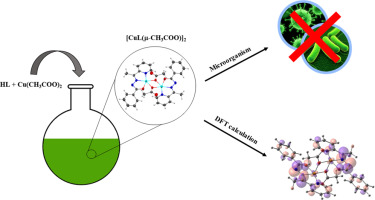当前位置:
X-MOL 学术
›
J. Inorg. Biochem.
›
论文详情
Our official English website, www.x-mol.net, welcomes your feedback! (Note: you will need to create a separate account there.)
DFT analysis, spectroscopic study and biological activity of a newly synthesized benzoylhydrazone binuclear Cu(II) complex.
Journal of Inorganic Biochemistry ( IF 3.9 ) Pub Date : 2019-11-29 , DOI: 10.1016/j.jinorgbio.2019.110949 Pedro H O Santiago 1 , Fernanda S Tiago 2 , Mariana S Castro 3 , Paulo E N Souza 4 , João B L Martins 2 , Claudia C Gatto 1
Journal of Inorganic Biochemistry ( IF 3.9 ) Pub Date : 2019-11-29 , DOI: 10.1016/j.jinorgbio.2019.110949 Pedro H O Santiago 1 , Fernanda S Tiago 2 , Mariana S Castro 3 , Paulo E N Souza 4 , João B L Martins 2 , Claudia C Gatto 1
Affiliation

|
The current work reports a joint experimental and theoretical study of a novel Cu(II) complex [CuL(μ-CH3COO)]2, based on 2-acetylpyridine-benzoylhydrazone ligand (HL). The two Cu(II) atoms are five-coordinated, consisting of three NNO-donor atoms from the hidrazone ligand connected by acetate bridges. In addition to the structural analysis, the complete characterization includes magnetic susceptibility, elemental analysis, FT-IR and UV-Vis. Two different approaches of Density Functional Theory (DFT) with localized basis set and plane waves were performed. The theoretical calculations were used to optimize the complex geometry of the new structure allowing a better understanding of its spectroscopic properties with insights of most important interactions. Thereunto, we made a comparison between the following functionals: B3LYP, PBE1PBE, B3PW91, ω-B97XD, M06 (hybrids), CAM-B3LYP (long range hybrid), and B97-d (pure), using localized basis set, and for plane waves we used the PW91 functional. Considering the expected antifungal and antibacterial activity of hydrazone derivative ligand, the antimicrobial activity of HL and the complex [CuL(μ-CH3COO)]2 was tested against pathogenic Gram-positive and Gram-negative bacteria and fungi. The synthesized new structure of hydrazone complexed with copper (II) shows antimicrobial activity, and magnetic susceptibility results indicate weak antiferromagnetic coupling between the copper atoms.
中文翻译:

新合成的苯甲酰hydr双核铜(II)配合物的DFT分析,光谱研究和生物活性。
当前的工作报告了基于2-乙酰基吡啶-苯甲酰hydr配体(HL)的新型Cu(II)络合物[CuL(μ-CH3COO)] 2的联合实验和理论研究。两个Cu(II)原子是五配位的,由来自Hidrazone配体的三个NNO供体原子(通过乙酸酯桥连接)组成。除了结构分析外,完整的特征还包括磁化率,元素分析,FT-IR和UV-Vis。进行了密度泛函理论(DFT)的两种不同方法,即使用局部基集和平面波。理论计算被用于优化新结构的复杂几何形状,从而通过最重要的相互作用的见解更好地了解其光谱性质。因此,我们对以下功能进行了比较:B3LYP,PBE1PBE,B3PW91,ω-B97XD,M06(混合动力),CAM-B3LYP(远程混合动力)和B97-d(纯净),使用局部基准集,对于平面波,我们使用PW91功能。考虑到derivative衍生物配体的预期抗真菌和抗菌活性,测试了HL和复合物[CuL(μ-CH3COO)] 2对致病性革兰氏阳性和革兰氏阴性细菌和真菌的抗菌活性。with与铜(II)配合的合成新结构显示出抗菌活性,磁化率结果表明铜原子之间的反铁磁耦合较弱。测试了HL和复合物[CuL(μ-CH3COO)] 2对致病性革兰氏阳性和革兰氏阴性细菌和真菌的抗菌活性。with与铜(II)配合的合成新结构显示出抗菌活性,磁化率结果表明铜原子之间的反铁磁耦合较弱。测试了HL和复合物[CuL(μ-CH3COO)] 2对致病性革兰氏阳性和革兰氏阴性细菌和真菌的抗菌活性。with与铜(II)配合的合成新结构显示出抗菌活性,磁化率结果表明铜原子之间的反铁磁耦合较弱。
更新日期:2019-11-30
中文翻译:

新合成的苯甲酰hydr双核铜(II)配合物的DFT分析,光谱研究和生物活性。
当前的工作报告了基于2-乙酰基吡啶-苯甲酰hydr配体(HL)的新型Cu(II)络合物[CuL(μ-CH3COO)] 2的联合实验和理论研究。两个Cu(II)原子是五配位的,由来自Hidrazone配体的三个NNO供体原子(通过乙酸酯桥连接)组成。除了结构分析外,完整的特征还包括磁化率,元素分析,FT-IR和UV-Vis。进行了密度泛函理论(DFT)的两种不同方法,即使用局部基集和平面波。理论计算被用于优化新结构的复杂几何形状,从而通过最重要的相互作用的见解更好地了解其光谱性质。因此,我们对以下功能进行了比较:B3LYP,PBE1PBE,B3PW91,ω-B97XD,M06(混合动力),CAM-B3LYP(远程混合动力)和B97-d(纯净),使用局部基准集,对于平面波,我们使用PW91功能。考虑到derivative衍生物配体的预期抗真菌和抗菌活性,测试了HL和复合物[CuL(μ-CH3COO)] 2对致病性革兰氏阳性和革兰氏阴性细菌和真菌的抗菌活性。with与铜(II)配合的合成新结构显示出抗菌活性,磁化率结果表明铜原子之间的反铁磁耦合较弱。测试了HL和复合物[CuL(μ-CH3COO)] 2对致病性革兰氏阳性和革兰氏阴性细菌和真菌的抗菌活性。with与铜(II)配合的合成新结构显示出抗菌活性,磁化率结果表明铜原子之间的反铁磁耦合较弱。测试了HL和复合物[CuL(μ-CH3COO)] 2对致病性革兰氏阳性和革兰氏阴性细菌和真菌的抗菌活性。with与铜(II)配合的合成新结构显示出抗菌活性,磁化率结果表明铜原子之间的反铁磁耦合较弱。



























 京公网安备 11010802027423号
京公网安备 11010802027423号